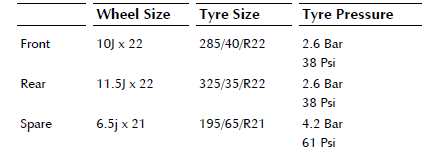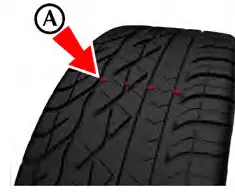Aston Martin DBX 2021 Chassis Systems User Manual
Chassis Systems
Vehicle Body
Five door hatchback with 2+3 seating.
Bonded extruded aluminium monocoque body structure with aluminium and composite body panels.
Steering
Electrically assisted, speed-sensitive rack and pinion power steering. Column adjustment for reach and tilt.
Turns Lock to Lock
2.59 turns.
Turning Circle
12.725 m.
Brakes
Foot Brake
Park Brake
Integrated electric park brake in each rear brake calliper.
Chassis Features
- Anti-Lock Braking System (ABS).
- Hydraulic Brake Assist (HBA).
- Electronic Brake Force Distribution (EBD).
- Four-stage Electronic stability Program (ESP).
- Electronically controlled rear differential (E-Diff).
- Front and rear 48V electronic Active Roll Control (ARC) system.
- Height adjustable and self levelling air suspension.
Wheels and Tyres
Wheel and Tyre Information

Tyre Loading
Tyres installed to this vehicle shall have a maximum load rating not less than 1060 kg (2337 lbs) front and 1180 kg (2601 lbs) rear, or a load index of 110 (front) and 114 (rear).
Tyre Pressures
Make sure that correct tyre pressures are carefully maintained. Road holding, steering, braking and tyre wear are especially vulnerable to incorrect tyre pressures.
Check tyre pressures regularly and before starting any journey, and adjust accordingly.
Tyre pressures increase slightly when the tyres are hot. For an accurate reading, tyre pressures should be checked when the tyres are cold. After adjusting the tyre pressures, make sure that the valve caps are securely replaced to provide an additional air seal and to prevent the ingress of dirt.
Wheel Bolt Torque
For wheel bolt torque (Refer to ’Wheel Bolt Torque’, page 11.50).
Wheel Alignment
For the most up-to-date wheel alignment values, contact your Aston Martin dealer
Tyre Information
Tyres of the correct type, manufacturer and dimensions, with correct cold inflation pressures are an integral part of every vehicle’s design. Regular maintenance of tyres contributes not only to safety but to the designed function of the vehicle. Road holding, steering and braking are especially vulnerable to incorrectly pressurised, badly installed or worn tyres. Tyres of the correct size and type, but made by different manufacturers can have widely varying characteristics.
Damage
Because of the high performance potential of this vehicle, Aston Martin strongly recommend replacement of any damaged or worn tyre.
Tyres should be examined at regular intervals for wear and damage. Inspect the tyre treads and sidewalls for damage, i.e. bulges in the tread or the sidewalls, cracks in the tread groove and separation in the tread or the sidewalls. If damage is observed or suspected have the tyre inspected by a tyre professional.
Stones or other objects which have become lodged in the tyre treads should be carefully removed.
Flat Spots
It is a characteristic of high performance tyres that temporary ’flat spots’ may develop if the vehicle is left standing in high or low ambient temperatures for any length of time.
These ’flat spots’ will manifest themselves as minor vibrations when the vehicle is first driven from cold. As the tyres warm up to operating temperature, normal tyre shape should be restored and the vibrations cease. If vibrations persist, consult your Aston Martin Dealer.
Flat Spots
It is a characteristic of high performance tyres that temporary ’flat spots’ may develop if the vehicle is left standing in high or low ambient temperatures for any length of time.
These ’flat spots’ will manifest themselves as minor vibrations when the vehicle is first driven from cold. As the tyres warm up to operating temperature, normal tyre shape should be restored and the vibrations cease. If vibrations persist, consult your Aston Martin Dealer.
Running-In New Tyres
When new tyres have been installed, speed should be limited, particularly during the first 80 km or so of driving. Fast cornering, hard braking, and harsh acceleration should also be avoided during this period.
Tread Wear Marks
Tread wear marks (A) are incorporated into the construction of all tyres. These marks are integral moulded ribs spaced at regular intervals around the circumference of the tyre and extend across the full width of the tread, in all primary grooves.
When a tyre has worn causing one or more of the marks to be flush with the outer face of the tread the tyre has reached its wear limit. It then becomes illegal in certain countries and must be replaced.
Summer Tyres
Summer tyres should be used if the highest level of dynamic performance is required and are best used for temperatures greater than 10°C. If the vehicle is used in temperatures below this for extended periods of time, then All-Season or Winter tyres should be considered. The tyres are also of different sizes on the front and rear axles, therefore complete wheels cannot be swapped between axles.
All Season Tyres
All-Season tyres are best used in temperatures between -10°C and +15°C. These tyres are suitable for mild off-road use as well as on-road use and an optimal tyre for use in Terrain and Terrain+ modes. All-Season tyres do have some winter driving capability, but for improved traction on snow winter tyres are recommended.
Winter Tyres
Winter tyres are designed for use in temperatures between -35°C and +10°C. These tyres have tread patterns and rubber compound that has been developed to maximise traction on snow and asphalt at low temperatures. This does mean that winter tyres have a lower maximum speed rating of 240 km/h (150 mph). In some countries, it is a legal requirement to display an appropriate speed limit warning sticker or use the winter tyre speed limit function (Refer to ’Vehicle Settings’, page 10.4)
Snow Traction Devices
Warning: The maximum speed when using snow traction devices is 48 km/h. Remove the snow traction devices immediately when the roads are clear of snow.
These are for temporary use when driving in heavy snow conditions. Snow traction devices should only be installed to the rear wheels. For more information regarding the correct snow traction device to fit to your vehicle, contact your Aston Martin Dealer.
Aston Martin 2023 Top Accessories
[amalinkspro_table id=”32446″ new-window=”on” nofollow=”on” addtocart=”off” /]
Aston Martin DBX Specs, Price, Features, Milage (brochure)
Reference Links
View Full User Guide: Aston Martin DBX 2021 User Manual
Download Manuals: https://www.astonmartin.com/en/owners/owners-guides


